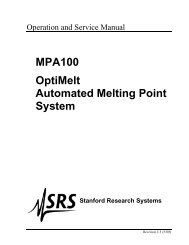Quartz Crystal Microbalance Theory and Calibration - Stanford ...
Quartz Crystal Microbalance Theory and Calibration - Stanford ...
Quartz Crystal Microbalance Theory and Calibration - Stanford ...
You also want an ePaper? Increase the reach of your titles
YUMPU automatically turns print PDFs into web optimized ePapers that Google loves.
www.thinkSRS.com<br />
2. A fixed gain amplifier with gain A 1 = 45dB + 20 log (250/200) = 46.94dB (or -<br />
222x.) This inverting amplifier has a b<strong>and</strong>width of 500MHz, <strong>and</strong> so introduces<br />
very little extraneous phase shift.<br />
3. A source resistance, R s , of 100Ω. This source resistance consists of two series<br />
50Ω resistors, one of which is inside the amplifier A 1 . This source impedance is<br />
reduced by a factor of 4x, to 25Ω, by the 2:1 transformer which follows.<br />
4. An isolation transformer with a 2:1 turns ratio, hence an attenuation of A t =<br />
0.5x. This transformer allows galvanic isolation of the crystal from the oscillator<br />
circuit which is important in electrochemistry applications. In addition to reducing<br />
the source impedance by 4x, the transformer also increases the load impedance<br />
seen at the input of the transformer by 4x, so that when R m =0Ω, the load will be<br />
200Ω.<br />
5. R m , the motional resistance of the crystal at series resonance. R m can vary<br />
from about 10-40Ω for a dry crystal, to about 375Ω for a crystal in water, to about<br />
5kΩ for a crystal in 90% (w/w) glycerol/water solution.<br />
6. A second isolation transformer with a turns ratio of 1:1. This transformer allows<br />
galvanic isolation of the crystal from the oscillator circuit.<br />
7. A load resistance, R L , of 50Ω. The network of R s , R m , <strong>and</strong> R L provide a<br />
network attenuation, A n , which depends on the crystal’s motional resistance.<br />
A n = R L / ( R s /4 + R m + R L ).<br />
8. An RF amplifier with an adjustable gain, A 2 , of about 4.43x. The gain of this<br />
amplifier, A 2 , is set during calibration to compensate for gain variations of all the<br />
other circuit elements.<br />
9. A low pass filter. This filter is a 5 th order Bessel low pass filter with f c = 3.7MHz,<br />
adjusted so as to provide 180º of phase shift at 5MHz. The phase shift of this<br />
filter, together with the 180º phase shift of the inverting amplifier A 1 , provides the<br />
360º of phase shift necessary for oscillation. The low pass filter is required to<br />
suppress spurious oscillations which would occur due to the high b<strong>and</strong>width of<br />
the loop amplifiers. The low pass filter attenuates a signal at 5MHz by about A f =<br />
-7.8dB (or 0.407x).<br />
The motional resistance of the crystal at series resonance can now be computed.<br />
The product of the gain (or attenuation) of all of the elements around the loop is<br />
exactly one when the circuit is oscillating at constant amplitude. Hence,<br />
A a · A 1 · A t · A n · A 2 · A f = 1<br />
<strong>Stanford</strong> Research Systems (408)744-9040

















